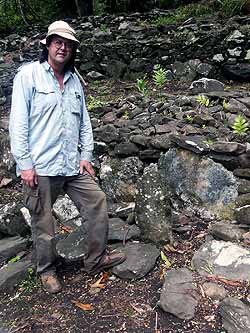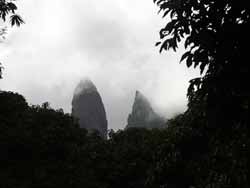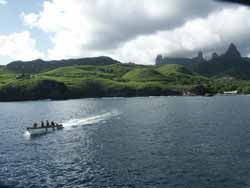by Paul Ross
Despite the predominance of modern attitudes and Catholic faith in the islands of the South Pacific, the people of the Marquesas Islands still have close encounters with terrifying, shape-changing ancestral spirits. PAUL ROSS travelled to the land of the tupapau to hear their stories. All photographs by the author.
Dancers
Grapes
Even today’s live Marquesan islanders can be menacing. How much more so are their dead ancestral spirits when they return as tupapau?
Fifteen-year-old Tahiatohiupoko Hita (sometimes known by his obligatory Western nickname of ‘Martin’) used to be just like most contemporary Marquesans: modern, staunchly Catholic and unbelieving of Polynesian legends and superstitions – largely because he didn’t know them. But all that changed late one afternoon during a ride across his home island of Ua Pou. At dusk, as he approached a high ridge, his mount balked; eyes wide, nostrils flared, its neck fought the tightened reins as Martin struggled to keep control of the terrified animal. He looked around, but could see nothing unusual. Despite the hot trade winds there was a distinct chill in the air. The hair stood up on the back of his neck.
SUDDENLY AN ENORMOUS BLACK CAT BOUNDED FROM THE OPENING OF THE CAVE

Martin
‘Martin’ guides tourists around his Marquesan home island of Ua Pou, but doesn’t volunteer stories of the tupapau.
Without consciously knowing why, Martin looked upwards to a nearby cliff face and noticed a small cave he’d never seen before. Suddenly, an enormous black cat bounded from the opening, landing silently only two metres from where Martin and his horse were now frozen to the spot. The cat looked directly at him for a few seconds that seemed an eternity, then turned, walked off slowly in the opposite direction, and vanished from sight as though it had never been there. The horse instantly calmed down; its rider, though, could not. He knew that there were no big cats on the island.

It was in these ancient burial caves where he encountered one in the form of a big black cat.
He was still visibly shaken when he arrived home, and his mother asked what had happened. When he told her, she immediately, and with great concern and secrecy, sent for a senior family member. The relative told Martin about the tupapau, ancestral spirits that can take many forms, both animal and human. The hillside cave, it turned out, was an almost forgotten ancient burial site. Foreign archæologists had never violated it, and so the spirits were still strong. Martin was a lucky boy, the old woman exclaimed; sometimes the tupapau do bad things to people.
Nearly 20 years later, Martin retells the story as though it were yesterday. He’s still Catholic, but now he’s also a believer in a very old tradition.
ONE FEMALE SPIRIT OFTEN MATERIALISES WITH A PET OCTOPUS ON HER SHOULDER
The ancient and modern worlds exemplified in the half-and-half tattooing of artist George Barff.
As well as appearing, as in Martin’s experience, as ABCs, tupapau are also said to favour the animal forms of dogs and pigs, all black and very large. Dr Robert Suggs, a leading authority on Polynesian culture and published specialist on the Marquesan Archipelagos 1, says that belief in the tupapau goes back to the very origins of the Pacific island peoples and their ancestral home on the south China coast some 6,000 years ago. Tupapau, he explains, “have tremendous spiritual power.” The word itself, common in both the Marquesan and Tahitian tongues, can mean ‘spirit’ or ‘cadaver’ in its original Austronesian form which, Suggs states, “is the most widely distributed (pre-European) language on Earth .from Madagascar to Easter Island.” Along with the language, many of the religious underpinnings of the culture survive today.
Dr. Paul Wallin stands before the digsite on the Maeva Hill complex.

Despite oral history claiming that departed spirits always rally at a beach site on Nuku Hiva as a takeoff point for the next world, Dr Suggs says he has never experienced anything more than an “uneasy feeling” at certain times during his explorations there. But his co-workers, outsider and native alike, have reported seeing and hearing strange things, and finding that objects are randomly moved about in classic poltergeist fashion. Dr Suggs hastens to add that, based on his research, tupapau are not perceived as inherently evil, but they are extremely touchy when it comes to people trespassing on sites that are tapu. In the old days, he says, “there were so many tapu places that locals had to zigzag around them to get anywhere on the island.” Even today, he tells me, at one vahi-mana (place of supernatural power), there is a female spirit that regularly materialises. with a pet octopus perched upon her shoulder. Sounding like a cross between a Disney character and Casper the Friendly Ghost, she’s friendly, helpful and “appears to people in the state between awake and asleep” to aid in healing.
Western-raised and educated Teikimaa-kautoua (‘Pascal’) Erhel Hatuuku returned home to his Marquesan island after completing schooling, contracted a fever and was in a hypnogogic state when he saw an old man standing outside his room, staring in at him intensely and repeatedly asking in a whispered rasp, “Aren’t you afraid of me?” When Pascal replied that he wasn’t, the old man began citing the evils that Pascal had committed during his lifetime. This litany was designed to instil fright, but in his semi-conscious state Pascal remained curiously detached. Their conversation continued through most of the night. Nobody else in the house – including a relative sleeping in a hammock adjacent to the room – heard anything. Pascal reflects that, through the experience, he has learned deep and profound things about his culture and experienced a personal reconnection to it; he has refused to tell anything further to any outsider.
RAYMOND HAD ALLIES IN THE OTHER WORLD WHO WOULD HELP HIM IN BATTLE
Scientist and tohunga Raymond Graff is a pivotal figure in the ongoing struggle between modern archeology and traditional island moresf.
This is far from the case with effusive, charismatic Raymond Graff. He too came back after an education in the world beyond the islands, and stays connected to the modern world through his presidency of the local Harley-Davidson Club. A controversial character, Graff is either viewed as a fire-walking tohua (spiritual leader) spearheading a return to ancient traditions or, conversely, as self-promoting, opportunistic and, in one particular instance, detrimental to scientific work. 2
Graff’s personal tupapau anecdote is even more confrontational than Pascal’s. Graff relates the adventure as if it were a spiritual pro-wrestling match. albeit one without a predetermined outcome. Alone on a jungle river bridge one moonless night, Graff “sensed something” and instinctively knew what it was. He shouted out a challenge: “If you want to fight me, I’m ready!”
In one corner, shadow spirits and, in the other, a human. Graff added that he had allied ancestors in the other world who would aid him in battle. Then – nothing. He walked on that night without incident. “Tupapau are more afraid of me.!” he concludes. Local legend often credits “strong mana” (a composite of soul and life-force) with providing protection from tupapau but Graff claims that, in his case, it probably helped being born at night near a sacred tupapau stomping ground where his mother saw “a flying coffin.”
The tupapau are also said not to like water and more than one tale is related about a ‘friend of a friend’ whose spiritual possession was instantly reversed by an ocean baptism. This trans-cultural religious permeability is not a total surprise in a country where statues of Jesus and Mary are openly referred to as “Catholic tikis.” In French Polynesia, as in many colonised and missionised places, pre-European contact beliefs became syncretised with dominant Christianity or merely went deeply underground. The siege against indigenous practices has been going on for a long time. In his first novel Typee 3, which was based upon his experience of jumping a whaling ship in the Marquesas and includes a lot of historically accurate material, Herman Melville bemoans the fate of the “poor Hawaiians” whose culture and identity where being destroyed by missionaries, and this is in mid-1840! The latest ongoing crusades have come from contemporary Christian evangelicals and the Mormon Church.

Now reclaimed by jungle, this ancient ceremonial site on the island Huahine is one of the most important in all of Polynesia.
Raymond Graff and a few select others are attempting to lead a renewal of commitment by French Polynesian islanders to their traditional roots, even to the point of rejecting European dress and religion. (Similar actions are being undertaken by native peoples all over the world, from New Zealand to America.) While some aspects of this ideological battle, such as the recreation of ancient spiritual rites, can be dismissed as minor rear-guard skirmishes, others – political actions and legal confrontations – cannot.
THE ANCIENT SPIRIT OF THE ISLANDS IS STILL ALIVE HERE
Despite increasing amounts of bureaucratic red tape, brand new excavations have recently taken place on the Mara’ire’a hill complex on Huahine, carried out by Dr Paul Wallin of Norway’s Kon-Tiki Museum 4 and Dr Reidar Solsvik of the University of Oslo. Extending the fieldwork of the eminent Polynesian archæologist Dr Yoshihiko Sinoto 5, a series of 35 large stone foundations (pi-pi or pae-pae) for walls, terraces, houses, marae and burial platforms have been cleared from the jungle. Preliminary carbon dating indicates occupation as far back as the 13th century and supports current theory about centuries of Pacific migration emanating from the island of Ra’iatea, some 18 miles (29km) eastward 6.
While this research is ongoing, questions of authenticity, ownership, preservation, reconstruction and tourism are drawing definite lines between island authorities and outside scientists.
“There is no local funding to continue (to preserve) the new dig site,” says Dr Wallin, whose personal commitment to Polynesian island culture includes a new ankle tattoo, which is partly for decoration and partly for unspecified protection. When asked if he believed in tupapau, he merely smiles and shrugs enigmatically.
Misty Peaks
Mysterious, evocative and foreboding, the throats of old volcanoes form the peaks of the Marquesan island of Ua Pou.

So the ancient spirit of the islands is still alive in the remote Marquesas. Gauguin painted it, 8 local natives remain wary of it, and even visitors occasionally have a brush with the phantom phenomenon.
If you want to take the chance, the distant islands and atolls of French Polynesia can be accessed surprisingly affordably aboard the hybrid freighter/cruiseship Aranui III. (http://www.aranui.com/)
NOTES
1 Dr Robert Suggs, The Island Civilizations of Polynesia, New American Library, New York, 1960.
2 A prominent ceremonial site, painstakingly reconstructed after research by leading Polynesian archæologist Dr Sinoto from Hawaii’s Bishop Museum, was reconfigured by Graff “from a vision” in a move that’s as political as it is controversial.
3 Herman Melville, Typee: A Peep at Polynesian Life, 1846
4 www.kon-tiki.no (Ironically, Thor Heyerdahl’s groundbreaking premise about Polynesian origins in South America has been discounted. There are, however, remaining mysteries, like how the New World sweet potato found its way to the middle of the South Pacific ocean.)
5 YH Sinoto and E Komori, Settlement pattern survey of Mata’ire’a Hill, Maeva, Huahine, French Polynesia, Department of Anthropology, BP Bishop Museum, Honolulu, 1988. Dr Sinoto is the recipient of Japan’s highest cultural honour, the Order of the Rising Sun, and was knighted by the President of French Polynesia for his lifetime of work.
6 Ra’iatea’s ancient name was Havai’i and is thought to be the emanation point of Polynesian ali’i culture through present-day French Polynesia (which includes the Society Islands as well as the Austral, Gambier, Tuamotu and Marquesas Archipelagos and atolls) and from Aotearoa (New Zealand) to Rapanui (Easter Island) to Hawaii. Many people may have migrated to flee the theocratic rule and human sacrifices of the priests of ‘Oro, the war god. Both Raiatea and Fakarava islands are sources of new archæological and history-changing information to be scientifically presented over the course of the next couple of years.
7 www.island-eco-tours.com
8 Manao Tupapau [literally “to remember the spirit”] (1892). A new Gauguin museum, complete with a reproduction of his infamous Maison du Jouir (House of Pleasure), debuted during the recent 100th anniversary of the artist’s death at the village of Atuona on the island of Hiva Oa, not far from his gravesite and just a headstone’s throw from the final resting place of the great Belgian singer-songwriter Jacques Brel.
PLEASE NOTE: Photos are available for all locations and articles listed in the “articles” section. Please contact us for samples and pricing.
CONTACT INFORMATION: [email protected]
